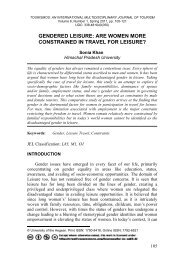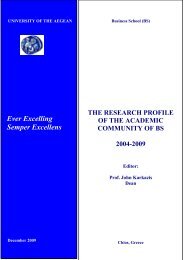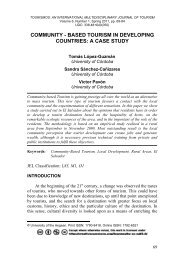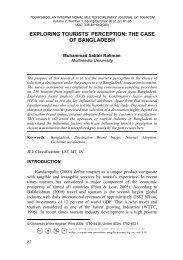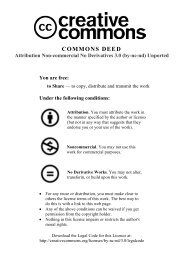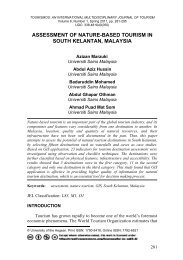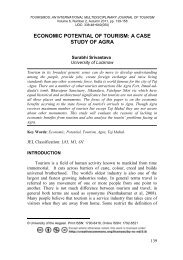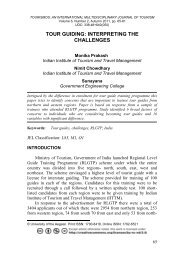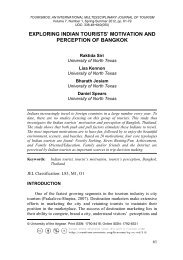TOURISMOS is an international, multi-disciplinary, refereed (peer ...
TOURISMOS is an international, multi-disciplinary, refereed (peer ...
TOURISMOS is an international, multi-disciplinary, refereed (peer ...
You also want an ePaper? Increase the reach of your titles
YUMPU automatically turns print PDFs into web optimized ePapers that Google loves.
Maria Alebaki & Olga Iakovidou<br />
“winescape” (Peters, 1997, cited in Hall et al., 2000). Three components<br />
constitute the winescape: the presence of vineyards, the wine production<br />
activity <strong>an</strong>d the wineries where the wine <strong>is</strong> produced <strong>an</strong>d stored (Telfer,<br />
2001).<br />
Hall & Mitchell (2002:69, cited in Sparks, 2007) d<strong>is</strong>cuss the concept<br />
of “tour<strong>is</strong>t terroir” in order to describe “the unique combination of the<br />
physical, cultural <strong>an</strong>d natural environment (that) gives each region its<br />
d<strong>is</strong>tinctive tour<strong>is</strong>t appeal”. In fact, someone who engages in wine-related<br />
tour<strong>is</strong>m, seeks for <strong>an</strong> overall tour<strong>is</strong>m experience, which offers a regional<br />
“bundle of benefits” (Getz & Brown, 2006), such as the rural l<strong>an</strong>dscape<br />
<strong>an</strong>d the appealing environment (de Blij, 1983:4), cultural heritage,<br />
festivals, rom<strong>an</strong>ce <strong>an</strong>d relaxation, exploration, (Carmichael, 2005),<br />
social<strong>is</strong>ing, communing with other people, hospitality, meeting the<br />
winemaker, or learning about wine (Al<strong>an</strong>t & Bruwer, 2004; Charters &<br />
Ali-Knight, 2000; Dodd, 1995). Authenticity, regional culture <strong>an</strong>d<br />
gastronomy are closely linked to wine tour<strong>is</strong>m. As Simon states: “Where<br />
vines flour<strong>is</strong>h, McDonalds seldom does. Good authentic food <strong>is</strong> surely a<br />
prerequ<strong>is</strong>ite for <strong>an</strong>y wine-orientated holiday, <strong>an</strong>d wine <strong>an</strong>d food grow up<br />
together in these [wine producing] regions” (Simon, 2001:6, in Boniface,<br />
2003:132). For all the above reasons, wine tour<strong>is</strong>m has been recogn<strong>is</strong>ed<br />
as a form of agricultural tour<strong>is</strong>m, rural tour<strong>is</strong>m, cultural tour<strong>is</strong>m,<br />
industrial tour<strong>is</strong>m <strong>an</strong>d special interest tour<strong>is</strong>m (Yu<strong>an</strong> et al., 2005).<br />
Getz (2000) argues that wine tour<strong>is</strong>m should be examined from three<br />
major perspectives: wine producers, tour<strong>is</strong>m agencies <strong>an</strong>d consumers.<br />
Getz & Brown (2006) comment: ‘‘Wine tour<strong>is</strong>m <strong>is</strong>, simult<strong>an</strong>eously a<br />
form of consumer behaviour, a strategy by which destinations develop<br />
<strong>an</strong>d market wine-related attractions <strong>an</strong>d imagery, <strong>an</strong>d a marketing<br />
opportunity for wineries to educate <strong>an</strong>d to sell their products directly to<br />
consumers”. Thus, underst<strong>an</strong>ding wine-related consumer behavior <strong>is</strong> vital<br />
<strong>an</strong>d c<strong>an</strong> achieve marketing benefits (Yu<strong>an</strong> et al., 2006; Dodds & Butler,<br />
2010). Towards th<strong>is</strong> direction, market segmentation <strong>is</strong> signific<strong>an</strong>t for wine<br />
tour<strong>is</strong>m operators in terms of product development <strong>an</strong>d marketing<br />
purposes (Mitchell et al., 2000; Williams & Kelly, 2001) as it provides <strong>an</strong><br />
underst<strong>an</strong>ding of wine tour<strong>is</strong>ts <strong>an</strong>d their behaviour.<br />
Market segmentation has been defined as … “the process of dividing<br />
a market into d<strong>is</strong>tinct subsets of consumers with common needs or<br />
character<strong>is</strong>tics <strong>an</strong>d selecting one or more segments to target with a d<strong>is</strong>tinct<br />
marketing mix” (Schiffm<strong>an</strong> et al., 2001:54, cited in: Bruwer et al., 2002).<br />
Usually, market segmentation <strong>is</strong> based on socio-economic variables<br />
(gender, age, income, educational level). However, in wine tour<strong>is</strong>m<br />
literature several psychographic variables are used as criteria for<br />
124



